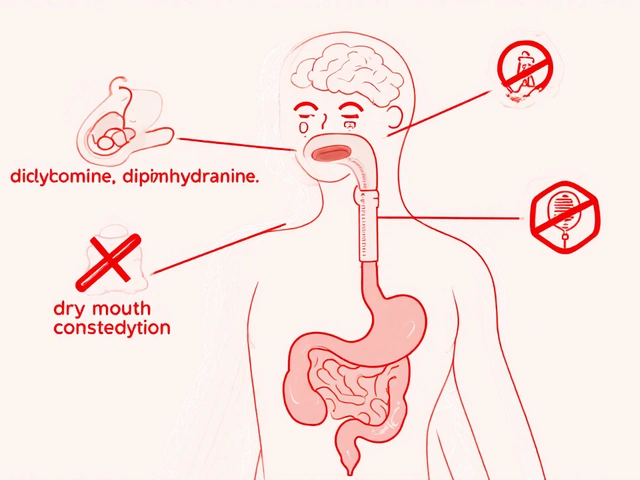TL;DR
- Acamprol is an oral antihypertensive used mainly for high blood pressure.
- Typical adult dose starts at 50mg once daily, titrated up to 100mg based on response.
- Common side effects include dizziness, fatigue, and mild headache.
- Avoid if you have severe liver disease, pregnancy, or are taking MAO‑inhibitors.
- Contact a doctor immediately for chest pain, rapid swelling, or sudden vision changes.
What is Acamprol?
Acamprol belongs to a class of drugs called calcium‑channel blockers. It works by relaxing the smooth muscles in blood vessel walls, which allows the vessels to widen and reduces the pressure the heart has to pump against. In Australia, the medication is marketed under the brand name Acamprol and is prescribed for adults with stage1 or stage2 hypertension when lifestyle changes alone aren’t enough.
The drug was first approved by the Therapeutic Goods Administration (TGA) in 2018, and since then several large‑scale studies have confirmed its efficacy in lowering systolic blood pressure by an average of 12mmHg and diastolic pressure by about 8mmHg over a 12‑week period.
How Acamprol Works in the Body
Acamprol blocks L‑type calcium channels on the vascular smooth muscle cells. Calcium ions are essential for muscle contraction; by limiting their entry, the drug prevents the muscles from tightening. This vasodilation lowers peripheral resistance, which is the main driver of high blood pressure.
Beyond blood pressure control, the medication also has modest effects on myocardial oxygen demand, making it useful for patients who have both hypertension and early signs of angina. However, it is not a first‑line treatment for heart failure because it doesn’t significantly affect cardiac output.
Key pharmacokinetic points you should know:
- Oral bioavailability is about 78%.
- Peak plasma concentrations occur 2‑3hours after ingestion.
- It is metabolised primarily by the liver (CYP3A4 pathway) and excreted unchanged via the kidneys (≈60%).
- Half‑life ranges from 10‑12hours, supporting once‑daily dosing for most adults.
Dosage Guidelines and How to Take Acamprol Safely
Getting the dose right is crucial for blood‑pressure control and for limiting side effects. Below is a step‑by‑step approach most clinicians follow:
- Initial assessment: Verify baseline blood pressure, liver and kidney function, and any current medications.
- Start low: Prescribe 50mg taken with breakfast to minimise orthostatic dizziness.
- Monitor: Re‑check blood pressure after 1‑2 weeks. If systolic stays above 140mmHg, increase to 75mg.
- Target dose: Most patients stabilise at 100mg once daily. Some may need a split dose (50mg twice a day) if they experience nocturnal hypertension.
- Special populations: For patients over 75years or with moderate renal impairment (eGFR30‑59mL/min), start at 25mg and titrate slowly.
Never double‑dose to “make up” for a missed pill. Instead, take the next scheduled dose at the usual time and skip the forgotten one.
Below is a quick reference table that summarises typical dosing scenarios:
| Patient Profile | Starting Dose | Target Dose | Notes |
|---|---|---|---|
| Healthy adult (18‑65) | 50mg daily | 100mg daily | Take with food to lower stomach upset. |
| Older adult (>75) | 25mg daily | 50‑75mg daily | Monitor for dizziness. |
| Renal impairment (eGFR 30‑59) | 25mg daily | 50mg daily | Check kidney labs every 3months. |
| Hepatic disease | Contraindicated | - | Seek alternative antihypertensive. |

Potential Side Effects and Risks
Like any medication, Acamprol carries a risk profile. The good news is that most adverse events are mild and resolve on their own. Here’s what you’re most likely to encounter:
- Dizziness or light‑headedness: Usually occurs in the first week as your body adjusts to lower blood pressure.
- Headache: Transient, often improves with adequate hydration.
- Fatigue: May be related to reduced cardiac workload.
- Peripheral edema: Swelling of ankles is reported in about 5% of patients; elevate legs and discuss diuretic options if it persists.
- Gastrointestinal upset: Nausea or mild abdominal discomfort; taking the pill with food helps.
Serious but rare reactions (<0.1%) include:
- Severe hypotension leading to syncope.
- Allergic skin rash or angio‑edema.
- Elevated liver enzymes.
If you notice chest pain, sudden vision loss, or a rapid increase in swelling, seek emergency care.
Drug interactions are an essential part of safety. Acamprol should not be taken with:
- Other calcium‑channel blockers (risk of additive hypotension).
- MAO‑inhibitors (can cause unpredictable blood‑pressure spikes).
- Strong CYP3A4 inhibitors such as ketoconazole or clarithromycin (may increase Acamprol levels).
Always inform your prescriber about over‑the‑counter meds, herbal supplements (e.g., StJohn’s wort), and any recent changes in your medication list.
Frequently Asked Questions About Acamprol
Below are the most common queries patients have after starting Acamprol, along with concise answers.
- Can I drink alcohol while on Acamprol?
- Moderate alcohol (up to one standard drink per day) is generally safe, but excessive intake can amplify dizziness and lower blood pressure further.
- Is Acamprol safe during pregnancy?
- No. The drug is classified as CategoryD in Australia, meaning there is evidence of fetal risk. Switch to a pregnancy‑compatible antihypertensive under medical supervision.
- Do I need regular blood tests?
- Baseline liver and kidney panels are recommended before starting. Follow‑up labs every 6‑12months help catch any emerging issues.
- What should I do if I miss a dose?
- Take the missed dose as soon as you remember, unless it’s within 12hours of the next scheduled dose. In that case, skip the missed one and resume your regular schedule.
- Can Acamprol be taken with my other blood‑pressure medicine?
- It can be combined with ACE inhibitors or diuretics, but only under a doctor’s guidance to avoid excessive blood‑pressure drop.
Next Steps and Troubleshooting
After reading this guide, you should be able to:
- Identify whether Acamprol is appropriate for your condition.
- Start the correct dose and know how to titrate safely.
- Recognise common side effects and when to seek medical help.
- Navigate drug‑interaction pitfalls.
- Ask your healthcare provider informed questions.
If you experience persistent dizziness, consider adjusting the timing of your dose (e.g., taking it after breakfast instead of on an empty stomach) and discuss a possible lower starting dose with your doctor.
Should side effects become intolerable, your prescriber may switch you to an alternative class such as an ARB (angiotensinII receptor blocker) or a thiazide diuretic. Keep a symptom diary for at least two weeks before making changes; this provides concrete data for your clinician.
Finally, remember that medication is only one part of hypertension management. Pair Acamprol with lifestyle measures-regular exercise, reduced sodium intake, and stress‑relieving activities-for the best long‑term outcomes.







liam coughlan
September 22, 2025 AT 09:17Benjamin Gundermann
September 22, 2025 AT 09:59Rachelle Baxter
September 23, 2025 AT 01:35Dirk Bradley
September 24, 2025 AT 11:03Mariam Kamish
September 24, 2025 AT 12:52Manish Pandya
September 26, 2025 AT 04:10Maeve Marley
September 27, 2025 AT 01:05James Gonzales-Meisler
September 27, 2025 AT 14:01Shawn Baumgartner
September 29, 2025 AT 02:04Navin Kumar Ramalingam
September 29, 2025 AT 23:42James Gonzales-Meisler
October 1, 2025 AT 02:23